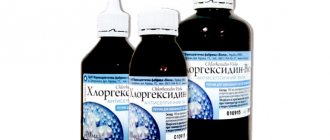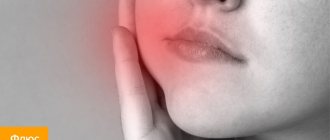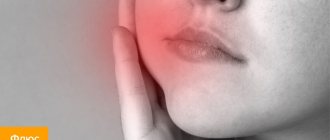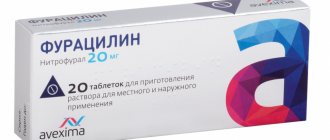Content:
- Causes of pathology
- Symptoms
- How to rinse with flux - the simplest and safest recipe
- Pharmacy products for flux processing
- Folk recipes
- Why you can’t treat gumboil yourself
- How do doctors treat flux?
Periostitis of the jaw or gumboil is a dangerous dental disease.
It is caused by an infectious-inflammatory process localized in the tissues of the periosteum. The disease should be treated under the supervision of a dentist. The doctor will carry out the necessary antiseptic measures and tell you what to rinse your mouth with gumboil, and select antibiotics.
Self-medication for periostitis is most often ineffective. Moreover, as long as the patient experiments with different folk recipes, the inflammatory process will continue to spread. This will lead to premature loss of the unit - partial edentia.
Remember: rinsing with flux is not a panacea, but only an auxiliary technique. There is no need to focus on it. Treatment of the disease must be comprehensive.
Antibiotics
The use of antibiotics is an important point in successful flux therapy. At an early stage, these medications can stop the spread of infection and prevent the appearance of an abscess. At later stages, when a purulent focus has already formed, antibacterial drugs are prescribed after opening it to prevent complications and speedy recovery.
Antibiotics for gumboils should not be taken independently. Only a dentist can give a recommendation which drug should be taken and in what dosage. This will depend on the patient’s age and weight, his condition and the presence of drug intolerance.
The most commonly used antibacterial agents for flux:
- Lincomycin
- Amoxicillin
- Tsiprolet
- Amoxiclav
- Doxycycline
- Ciprofloxacin
- Trichopolum
- Flemoxin solutab
- Biseptol
- Levomycetin
Antibacterial drugs should not be used for less than 5-7 days or stopped after the condition improves. This can cause drug resistance in the microorganism that caused the flux, and lead to loss of effectiveness of the drug if the disease reoccurs.
Causes of pathology
Before we tell you how to rinse flux, let’s explain why it occurs. Among the main reasons:
- progressive caries, when microorganisms from the resulting cavity penetrate the pulp and roots;
- poor-quality filling of teeth and canals;
- decreased immunity;
- inflammatory gum disease that has a chronic course;
- dominance of pathogenic microflora in the oral cavity.
It is necessary to establish the cause of the disease and only then treat it. Then the risk of flux recurrence will be much lower.
Symptoms
Periostitis affects the gums.
Visually, it resembles an inflamed abscess. May cause increased body temperature, swelling of the cheeks, lips, and neck. Always accompanied by pain. Pus is released from the flux. If the drainage channel has not yet formed, the patient can observe yellow-green contents under the mucous membranes of the gums.
The inflammatory process is strong, causing the immune system to mobilize. This results in increased fatigue and weakness.
It’s good if the periostitis breaks out. Then the cavity will cleanse itself naturally. But there is a possibility that pus gets into the facial tissues, reaches the bones, and penetrates the systemic bloodstream. Then there will be a threat to human life.
Pharmacological properties, form, indications
Chlorhexidine has a wide spectrum of effects. It destroys various types of bacterial agents, viral as well as fungal microorganisms. The drug stops the activity of pathogens, reduces the inflammatory response, and reduces pain. The medicine remains active even if there is pus or blood in the area of the injury.
Indications for the use of Chlorhexidine in dentistry:
- removal of a tooth;
- gingivitis;
- stomatitis (including aphthous);
- periodontitis;
- alveolitis;
- toothache.
Chlorhexidine is produced in the form of a solution, gel, ointment, suppositories, and spray. For dental diseases, forms of spray, gel, solution (water, alcohol) are required. The solution in dentistry is used with a concentration of 0.05%.
The medicine should not be used if the patient has a severe allergy. In children, Chlorhexidine is used carefully, as allergic reactions are possible. You should not use the drug on your own, as it may cause complications.
Undesirable manifestations from using the medicine, according to the instructions, are:
- allergy;
- dry mucous membranes;
- change of teeth color;
- change in taste perception (with prolonged use);
- the appearance of tartar or its increase.
How to rinse with flux - the simplest and safest recipe
The most accessible composition is ordinary drinking water, in which soda and salt are dissolved. It is indicated for many dental ailments. Anyone can cook it. The listed components are usually found in any kitchen.
You need to add a teaspoon of salt and soda to a glass of warm (not hot!) water. Stir. If the patient tolerates iodine well, then you can include a few drops of it in the medicine. Then the liquid will acquire even more pronounced antiseptic properties.
Rinsing should be done on the sore side of the jaw. They should be repeated after every meal and hygiene procedures. If the pain is very severe, and it is not possible to get dental care right now, you can do a mouth bath with a soda-salt solution. To do this, you need to put it in your mouth and hold it on the side of the sore gum for several minutes.
Compresses and lotions
Compresses and lotions have an analgesic effect, limit the spread of the inflammatory process, and have a detrimental effect on pathogenic microorganisms.
Compresses with dimexide
Dimexide, when applied topically, perfectly penetrates into the inflammatory focus, inhibits the vital activity of microbes and increases their sensitivity to antibiotics. It is also able to eliminate pain. For a compress with flux, dimexide is diluted with warm water to a solution concentration of 20-30% (80 ml of liquid per 20 ml of the drug), after which a sterile napkin made of several layers of gauze is moistened with it. The compress is applied to the cheek in the affected area. The duration of the procedure is 1-2 hours. Repeat twice a day until pain and signs of inflammation are eliminated.
Before using Dimexide for the first time, it is necessary to test for an allergic reaction on the back of the elbow.
Lotions with soda
To treat gumboil, wrap a teaspoon of baking soda in several layers of gauze and place it between the cheek and gum for several hours. This will reduce swelling and relieve toothache. The lotion must be repeated 2-3 times a day.
Compress with salt
Salt has an anti-inflammatory effect, quickly relieves pain and reduces inflammation. To prepare a compress, dissolve 2-3 teaspoons of salt in 100 ml of warm water. A gauze or cotton swab is moistened with the solution and placed between the sore gum and cheek. Every 2 hours, change the compress to a new one until the acute symptoms subside.
It is better to use sea salt, which, due to the presence of iodine components, helps to relieve inflammation even better.
It is impossible to cure gumboil yourself without the participation of a dentist. Self-medication can be not only ineffective, but also dangerous. At home, you can only carry out those therapeutic procedures that have been recommended by a specialist.
Pharmacy products for flux processing
The pharmacy offers a wide range of solutions that can be used for diseases of the oral cavity. So, suitable for rinsing:
- Chlorhexidine. Aqueous composition that does not require additional dilution. It is allowed to use it five to six times a day. But under no circumstances should you swallow!
- Miramistin. Chlorhexidine substitute. Shows pronounced antiseptic properties. Accelerates the regeneration of affected tissues. It is often combined with oral antibiotics.
- Furacilin. Antimicrobial agent, nitrofuran derivative. Active against a number of gram-positive and gram-negative bacteria. You need to take one crushed tablet per glass of water.
- Betadine. Antiseptic containing iodine. If a person has a thyroid disease or is allergic to iodine products, this medicine will not suit him. Dissolve a tablespoon of Betadine in a glass of water. The only thing you need to remember is that the medicine can stain the enamel yellowish.
- Rotokan. Alcohol composition based on chamomile, calendula, yarrow. You need to take one tablespoon per liter of water. Dentists recommend using the solution at intervals of three hours.
- Malavit. A preparation containing silver and copper ions. A very powerful, yet safe antiseptic. Destroys pathogenic microflora. If you use it to remove flux, the swelling will quickly go away. You only need to add ten drops of Malavit to a glass of water. There is no need to swallow it.
It is optimal if the dentist selects the medicine for rinsing. With periostitis, any amateur activity is unacceptable.
The use of Chlorhexidine for swelling of the gums
The drug is indicated for relieving inflammation of local gum swelling after implantation or tooth extraction. Its antimicrobial properties help avoid suppuration and infection of the wound. Helps reduce swelling and irritation of the mucous membrane.
On average, the course is 1 week. To perform oral baths, liquid is drawn into the mouth, held for 1-2 minutes and spit out. If the procedure is performed after brushing your teeth, you must thoroughly rinse off any remaining toothpaste. The components in its composition can sharply reduce the effectiveness of Chlorhexidine.
Folk recipes
Herbs and plant extracts have a beneficial effect on oral tissues. They can be used to relieve inflammation. When dealing with flux, you should arm yourself with:
- Oak bark. An infusion is prepared from it: pour two spoons into 200 ml of boiling water and wait for one hour. After filtering, the composition is ready for use. All products based on oak bark stain teeth. This is their significant drawback.
- Sage. You should mix a teaspoon of aromatic dry raw materials with a glass of hot boiling water. After half an hour, filter. During the procedure, the medicine should be slightly warm.
- Chamomile. Very popular for various dental diagnoses. Excellently suppresses inflammatory processes. Antiseptic. It can be combined with string and yarrow. The preparation recipe is standard: a tablespoon of vegetable mixture per glass of boiling water.
- Propolis. Suitable for making tinctures with alcohol. It must be infused strictly at room temperature. Dilute a teaspoon in a cup of water and rinse the flux in the morning, afternoon and evening.
Why you can’t treat gumboil yourself
Periostitis is a purulent disease. If treated incorrectly, it often causes dangerous complications. Therefore, dentists do not recommend that patients self-medicate. You can understand that the pathology has begun to progress rapidly by the following symptoms:
- severe weakness, increased physical fatigue;
- heat;
- severe swelling;
- headache;
- inability to chew food due to pain;
- facial distortion due to tumor.
With such symptoms, rinsing alone will not help. You need to urgently go to the doctor.
How do doctors treat flux?
As we wrote above, rinsing is an auxiliary technique. They must be combined with therapeutic applications and physiotherapy. Of the latter, the following are effective:
- UHF;
- laser therapy;
- electrophoresis;
- magnetic therapy.
The purulent acute form of the disease always requires surgical manipulation. The doctor opens the subperiosteal or submucosal abscess and installs a drainage tube into the gum. All procedures are performed under local anesthesia, so the patient does not feel pain.
Afterwards, the patient is prescribed antibiotics and rinses, and is told what precautions must be taken to avoid complications of periostitis. As a rule, recovery occurs within one week. If the crown and roots are severely damaged or inflammation is advanced, tooth extraction may be required.
Use of Chlorhexidine in dentistry
Upon contact with the mucous membrane, it forms a thin protective film. The effect lasts after the procedure for 24 hours.
Shown:
- with gingivitis;
- in case of development of periodontitis;
- against the background of treatment of stomatitis;
- in case of inflammation of the socket after tooth extraction;
- for inflammation caused by semi-impacted wisdom teeth;
- for disinfection of removable dentures;
- for root canal treatment;
- after installation of dental implants.
An alcohol-based chlorhexidine is used to treat the hands of a dental surgeon.
The antiseptic enhances the effect of surface anesthesia, therefore it is often prescribed together with Lidocaine. This reduces the number of bacteria at the injection site. Able to fight pathogenic microorganisms after removing stone and plaque.











